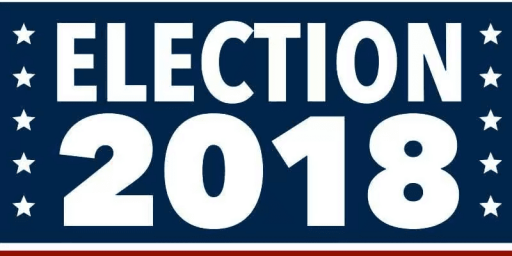Minority Rule Isn’t a Myth
The will of the majority can prevail even in a skewed system.

WaPo columnist Jason Willick contends “The midterms have busted the myth of conservative ‘minority rule.’” Spoiler alert: they did no such thing.
He begins with a bizarre comparison:
The 2022 midterms dealt a political blow to Republicans who claimed the previous election was rigged. But they also struck a blow against a subtler self-serving theory undermining faith in democracy from the left — that the electoral system itself suffers from a crisis-level “structural” bias against Democrats.
One of these things is not like the other. One is a claim, entirely without evidence, that the other party stole an election. The other is an observation, demonstrably true, that our system of elections is not majoritarian.
It’s hard to overstate the influence this idea has exerted on intellectuals over the past decade. Historian Kenneth Owen wrote in the Atlantic in 2020 that “minority rule is fast becoming the defining feature of the American republic.” In a 2021 law review article, scholar Pamela S. Karlan (a former Biden Justice Department official) argued that gerrymandering in the House and equal representation of states in the Senate were contributing to a “countermajoritarian drift in our politics.”
She wrote: “The way our nation is constituted may be interacting with the way our Constitution was written to produce one of those periods of retrenchment in which we move once again towards government by minority” — that is, a Republican minority in rural states and regions.
Owen’s piece was mostly about the Electoral College, which gave us Republican Presidents in 2000 and 2016 who lost the popular vote, in the latter case by some 3 million votes. Oddly Willick doesn’t even mention Presidential elections in his essay.
Karlan’s piece is more multifaceted and not even a partisan complaint; it’s simply an analysis of how fixed rules (the practice of a winner-take-all allocation of Electoral College votes, equal state representation in the Senate, a 435-seat House comprised of single-member districts, etc.) have disparate results over time (as demographics change, parties sort, etc.). It’s rather obvious to those who have studied these things and she provides ample citations to back her argument. And she acknowledges that the same system virtually assured Democratic House majorities for decades.
Willick’s strongest point is this:
The Cook Political Report tracks overall votes won by each party for the House. With more than 107 million votes counted but some still outstanding, Republican candidates are ahead 50.7 to 47.8 percent. That margin of nearly three percentage points tracks with the GOP lead in the pre-election RealClearPolitics polling average. Yet Republicans still fell short of expectations in the House: Instead of holding a commanding majority, they are on track to control 222 seats to Democrats’ 213.
The “structural advantage” that was supposed to amplify the representation of Republican voters failed to materialize. By one measure, the structure of House elections worked in Democrats’ favor. According to Cook’s data, the median House seat was Iowa’s 3rd District, where the Republican won by just 0.7 points. That means the district that decided control of the House was somewhat more Democratic than the country at large.
The House popular vote is an imperfect gauge of a party’s overall support because some districts are uncontested, but it’s still telling. After the elections of 2012, 2014 and 2016, the GOP held comfortable House majorities in excess of its popular-vote share. That was the result of efficient GOP redistricting after its 2010 electoral landslide and Democrats’ reliance on voters concentrated near cities.
The pattern changed with the Democratic wave in 2018. The past three congressional elections have seen a rough alignment between the parties’ national vote and their proportion of House seats. Instead of a “countermajoritarian drift,” American politics might be witnessing a majoritarian drift.
But, of course, those are different things. A “majoritarian drift” simply means that we’re (temporarily) experiencing a cycle where electoral outcomes roughly match the will of the electorate. That should be the norm, not the exception, no?
Of course, Congress aims to represent something deeper than a national popular vote. The United States inherited its system of electoral districts from the British Parliament, which evolved to spread political power across geographic regions. The Democratic coalition accomplished that fairly well in 2022, blunting GOP gains.
Whether 2022 America should be governed according to conditions that prevailed in 1700’s Britain is debatable. But nobody is proposing getting rid of representation at the local level. Rather, they’re arguing that House seats should reflect the will of voters in a given state instead of maximizing the interests of the party that draws the districts and that the Senate gives the people of low-population states too much power compared to those in high-population states.
That brings us to the Senate, the less-majoritarian of Congress’s two houses. Prophecies of inexorable Democratic doom in the upper chamber because of states’ ostensibly increasing GOP lean went unfulfilled as Democrats, despite the challenging midterm environment, picked up a seat in Pennsylvania and might even expand their majority if they win Georgia’s runoff election.
Modern American politics defies “scientific” models of partisanship, as state-specific patterns and candidates shape outcomes as much as standardized measures. Progressive wonks have mustered all manner of data purporting to show the geographic unfairness of the Senate, yet far from entrenching “minority rule,” the body continues to reflect the United States’ close political divisions. With partisan control of the House flipping at a historically fast pace, the Senate’s stabilizing function is more pronounced.
In the 118th Congress, Democrats are likely to be grateful for this. The Democratic Senate will kill much of the Republican House’s legislation. The argument that the Senate’s equal representation of small and large states is a grotesque distortion of democracy will become an awkward fit with progressive priorities. As a result, the delegitimization of “countermajoritarian” American institutions that arose in the past decade is likely to be submerged over the next two years.
This is sleight of hand that ignores the central argument: it’s simply undemocratic for California’s 39 million residents and Wyoming’s 579 thousand residents to have equal say in a legislative body. That’s true regardless of whether one is happy with the effects on public policy.
In the current Senate, only six states have split delegations, the fewest since we began electing Senators by popular vote. That is, 46 states have two Senators of the same political party. Presuming Raphael Warnock holds off Herschel Walker in the Georgia runoff, we’ll be down to five states with split delegations in the next Senate, as John Fetterman’s win in the seat vacated by Republican Pat Toomey consolidates Pennsylvania as a Democratic state.
There’s nothing inherent in any of this, for reasons Karlan details. There’s no reason low-population states are inherently Republican (indeed, Vermont, Delaware, Rhode Island, Maine, and Hawaii are pretty reliably Democratic and DC would be rock-solid Democratic were it admitted as a state) or high-population states are inherently Democratic (indeed, California was reliably Republican and Texas and Florida were reliably Democratic for a very long time).
But that doesn’t change the basic fact that the Senate (and by extension, the Electoral College) doesn’t represent the will of the American people equally.
Willick’s conclusion is, frankly, nonsensical:
Attacks on the legitimacy of the U.S. electoral system tend to come from the most disreputable and ill-informed voices in conservatism — and from the most highly esteemed and knowledgeable authorities in liberalism. They will continue. But for now, voters’ 2022 verdict should highlight the suppleness and integrity of American political institutions, and the advantages of playing by their rules instead of undermining their foundations.
Few Democrats—and none cited by Willick—argue that we shouldn’t play by the rules. While there were fringe calls for unfaithful Electors to give the 2016 election to Hillary Clinton—and less fringe complaints that Russian interference might have made the difference—it was almost universally acknowledged that Donald Trump won the election and should be sworn in as President.
Some called, once again, for shifting to a new system for electing future Presidents. It didn’t go very far. Regardless, that’s a very different thing, indeed, from fomenting insurrection to steal an already-held election.
Moreover, Willick’s central premise is simply wrong. That the will of the majority and the outcome of a particular election were in alignment doesn’t mean that the system isn’t skewed.
There have been 59 elections for President going back to 1789.* In 54 cases, the candidate with the most votes won. That’s a 91 percent success rate! That doesn’t mean that the system is a good one! The system gave us a President who lost the popular vote five times—twice in recent times. That’s problematic if you think that people should choose their political leaders.** That it’s possible to conceive of scenarios where Democrats win the White House after losing the popular vote doesn’t even things out.
Similarly, the fact that both the House and Senate are closely divided on a partisan basis, just as the country is, doesn’t mean that gerrymandered districts and unequal representation aren’t problematic. That Vermont’s Democratic lean balances out Montana’s Republican lean doesn’t change the fact that both are wildly overrepresented in the Senate.
UPDATE: It occurred to me that, because the column to which I was responding focused on electoral outcomes, I missed arguably the most anti-majoritarian facet of our political system: the Supreme Court. Despite the Republican Party having garnered a plurality of the popular vote in Presidential elections just once (2004) since the 1988 election, Republican Presdidents have appointed 6 of the 9 Justices on the body which has the power to decide which laws and Presidential orders are Constitutional. So, even when Democrats win elections, their polices are often thwarted.
_________________
*Granted, the very earliest ones didn’t have much in the way of a popular vote and women and Blacks were only allowed to vote much later.
**And this doesn’t even get into the fact that the winner-take-all nature of allocation in all but two states means people are forced to choose between the nominees of the two major parties if they want their vote to count. Or the fact that, in all but a handful of states, the outcome of the 2024 and 2028 elections can be reliably predicted today.






Instructive tweet by Willick:
First, it is patently ridiculous to argue that the US Senate is a source of progressive policies – especially if one were to compare the median political lean in the Senate with other developed countries.
Willick’s argument is basically that the Senate should more or less reflect what he thinks of as “centrist.” This, of course, is highly subjective. Maybe the actual will of the people is far to the left (or right) of that!
Second, and much more importantly, it doesn’t even matter if the Senate accidentally reflects the will of the people. The Senate should reliably reflect the will of the people.
Californians, New Yorkers, Texans, etc. are still being ridiculously underrepresented – even if they coincidentally happen to be politically in line with the average Wyomingite.
Willick just demonstrated that he fundamentally doesn’t (or doesn’t want to) understand democracy.
Which really makes me wonder why leading newspapers (which are owned by rich people) insist on hiring columnists who peddle such overly transparent nonsense.
It can’t be an accident.
My “never to be implemented” solution for the Senate is to do what they did to the House of Lords in the UK. Strip it of most of it’s legislative powers to being able to hold up the implementation of a bill for 90 – 120 days. I would also keep all the duties around executive branch confirmations and other administrative duties. They could also form draft committees to send bill ideas to the house like they do now but it would be more of a “suggestion” rather then a bill that would need reconciliation.
This would also be in conjunction of doubling the number of seats in the house and eliminate districts for the purpose of elections and populate the districts based on % of the vote to the party (This might also lead to more 3rd party votes). That would guarantee that the number of representatives in each state would have some vague relationship to “the will of the people”.
Yes it will never happen but hey, if you can’t dream at OTB… where can you dream ? 🙂
Tiny typo about giving us Republican presidents in 2000 and 2020 – should be 2000 and 2016. [Fixed! -jhj]
Otherwise, good piece, thank you for standing up for our country!
Sooooo many thoughts (some of which I have already shared on Twitter). But this is an excellent example of my ongoing assertion that the American press doesn’t understand American politics as well as they think they do.
And what the F does this mean?
It is blatantly obvious that the Senate entrenches minority rule. One doesn’t need to muster all manner of data to demonstrate that fact, instead one just needs to do some simple math and also understand some of the way the chamber functions.
Ugh.
That’s the storyline right there, isn’t it? A claim made without evidence is presented as equally valid to a demonstrably true observation of facts. Misinformation and dubious comparison continue through the entire piece. Willick’s sleight of hand is the new norm of political punditry and rhetoric.
I listened to Maria Ressa (author of How to Stand Up to a Dictator and Nobel Prize winner) yesterday on NPR’s 1A. What she shared about how social media disinformation has given rise to authoritarian regimes around the globe chilled my blood. Our post-factual information landscape will be the downfall of our democracy if not checked.
@Steven L. Taylor:
I contend Willick understands American politics perfectly well. It just doesn’t serve his interests to present his arguments honestly.
@drj:
Fixed that for you. He has a centrist axe he wants to grind and will ignore inconvenient facts and numbers and bend all the others to reach that goal.
One point Hendrik Hertzberg (a now-retired pundit who wrote a lot on the subject of electoral reform, and whose writings I highly recommend) used to make was that the biggest problem with the EC is not the occasional election where the winner of the popular vote is denied the presidency. The biggest problem is the way it skews the vote in every election, where the campaigns ignore the vast majority of states and where voters in most of those states have little incentive to vote.
And this is a problem that has increased over time because as the country has grown more polarized, the range of battleground states has greatly shrunk. If I recall (I’m not looking this up again), there were around 20 states considered battlegrounds in the 1960 election. In 2000 shortly before the election there were over a dozen states the pollsters considered to be tossups. If you look at elections of the past, there was generally a consistency between how big the national vote was and how many states were competitive. Of course there were the famous landslides, but even when you look at the close elections–1960, 1968, 1976–the closeness of the national vote was reflected in most of the states. Today, almost all of our elections are relatively close in popular margin (every 21st century election except 2008 has been within 5 points in the popular vote), yet within most states it’s just consistent landslides for one party, no matter what’s happening nationally. In 2020 there were really only seven states that could be reasonably termed battlegrounds (they were: WI, MI, PA, NC, GA, AZ, NV). By my calculation, those states together make up about 18% of the country’s population.
In this situation, it’s not so much that minority rule by one party is inevitable (obviously both parties can win) as that the vast majority of the country is irrelevant in determining the differences in outcome from one election to the next.
@Kylopod: The pathologies within our institutions are legion.
@Scott F.:
Why would you need to stand up to a Nobel Prize winner?
@Scott F.: I am going to say both can be true.
@Steven L. Taylor: I would agree, as I’m aware of Hanlon’s razor: Never attribute to malice that which is adequately explained by stupidity.
But, I believe assuming stupidity can provide cover to those acting with malice, so I’m mindful of that whenever I assess the rhetoric of a pundit or a politician.
@Mu Yixiao:
I recognize you’re ribbing me on my sentence structure, but have you seen this recent quote from potential GOP POTUS candidate Mike Pompeo?
There is ample evidence that those who are relying on disinformation see expertise (like that of Nobel Prize winners and education leaders) as a threat to their world order. Pompeo is saying smart people need to be stood up to more so than authoritarians.
@Steven L. Taylor:
Back when dinosaurs roamed free and I was taking American history in junior high school, our book seemed to be saying that the Senate was constituted specifically to overbalance in favor of less populated states–whose representatives to the Constitutional Convention were concerned about the possibility of “tyranny of the majority.” So yeah, my understanding is that entrenching minority rule was sort of baked in. To the extent that I can recall, that feature was considered as part of “checks and balances.”
@Mu Yixiao: I dunno. More interesting to me though is the question of which dictator is the Nobel Prize winner. The answer to that question alone may make the book worth reading. 😉
Swamped at work without much time.
So. long story short, the gerrymandering, packing, cracking, etc. used to tilt the balance in House districts, is probabilistic in nature. Factors like candidate quality, turnout, etc. will sometimes let the longer odds prevail.
Some safe red and blue districts will always be there, too, even if the candidate is terrible and turnout is low or three’s an opposite party wave.
Lastly, people make mistakes, courts sometimes get involved, and some states have non-partisan redistricting commissions. So you can’t rig all seats all the time, and you may get some wrong.
None of this negates the GQP has a House advantage. It just doesn’t work 100% all the time.
@Scott F.: I decided to kid you about sentence structure, too (alas, that carries over from when I used to ask the same questions of my writing students). More to the immediate point smart people needing to be stood up to more than authoritarians has been a feature rather than a bug in political discourse for a long time. Back when I was young, it was Herbert Marcuse–(supposed) apologist for Stalinism–who needed to be opposed because of his ability to corrupt young minds. (A role model for my future career goals, btw.)
@just nutha:
I expect it was presented as part of checks and balances. In reality it was just a compromise needed in 1788 to get the small states to sign on. And it could be changed, although it’s hard to see how we’d get the small states today to help ratify an amendment. Maybe, as @Rick DeMent: suggests, we could find some clever way to partially neuter the Senate as the Brits did with the House of Lords. Perhaps we could model our tactics on how the Brits got the Scottish parliament to vote for union. Bribery.
@gVOR08: I’m sure that it was a compromise needed to get small states to sign on (*in much the same was as the 3/5ths compromise was a concession to lower the population counts of states with extensive slavery). Somewhere along the line (I took US History I 4 total times), one or more sources admitted that position. Still in all at least a couple of versions of US I that I took, the perception that small states needed protection from perceived/real effects of being overwhelmed by a unified majority of large state interests was part of the discussion. I don’t know that as true–just as explanation, and to the extent that it is accurate, that account would put the configuration of the Senate in the larger checks and balances scheme, at least in my mind.
@just nutha: I forgot to include my asterisk note:
[CRT TRIGGER WARNING!!!] 😉
@Steven L. Taylor: I’d like to congratulate you on your successful brain graft of Dr. Joyner.
It is harder and harder to tell your posts apart on this subject. Well done!
@Gustopher:..successful brain graft of Dr. Joyner.
Are you sure it wasn’t the Vulcan Mind Meld?
(Can’t really see Taylor’s ears in his pic.)